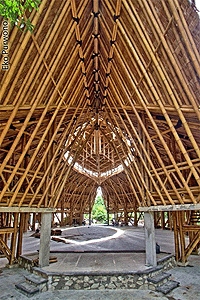According to a statement, bamboo holds a number of benefits over other construction materials as it grows extremely quickly, reaching maturity three times faster than hard woods, and is renowned for a strength that is comparable to steel.
However, inherent drawbacks currently prevent the widespread use of this material. Bamboo has limited durability when exposed to UV rays and humidity, and its thin walls and empty internal diaphragm imply that it has poor fire resistance.

The research team, including the universities of Cambridge and Coventry, is working to develop an understanding of the anatomy and structural applications of bamboo in order to modify it to overcome these limitations, while maintaining its unique mechanical properties.
Working in collaboration with Colombian organisations, including the National University of Colombia, the Andes’ University and the Colombian Bamboo Society, the researchers from UK institutions aim to draw on existing Colombian knowledge of bamboo to exploit this material in the construction industry.
Members of the team have returned from a fact-finding mission to Colombia run through the EPSRC-funded Low Impact Materials and innovative Engineering Solutions Network (LimesNet).
Hector Archila Santos, a Bath University PhD researcher on the project, said: ‘Our research in Bath has focused on the properties of the bamboo species Guadua angustifolia Kunth, which is a fast-growing, woody species native to tropical American regions.
‘We have investigated different processing techniques of using a flat form of bamboo traditionally used as sheet material of Guadua wall frame systems (bahareque). To overcome issues regarding the variability in thickness and density of bamboo, thermo-hydro-mechanical modifications have been undertaken, producing flat and regular surfaces suitable for lamination. Standardised cross-laminated bamboo panels are produced by gluing the faces with a high-performance epoxy resin.
‘We’ve imaged cross-sections of bamboo to identify structural components, such as the stiff vascular bundles. We’ve used transmission electron microscopy to identify cellular-level features and have measured the mechanical properties of bamboo through using micro-bend test using specimens from different positions in the bamboo stem.
‘Through the project we’ve explored options for producing high-performance composites, including the combination of bamboo fibres with bio-polymer matrixes and the reinforcement of bamboo with other fibre composites.’
A first publication that contextualises the research project at Bath has been published in ‘Low-Carbon Construction Using Guadua Bamboo in Colombia’ in Key Engineering Materials, and was presented at a LimesNet Research Conference held in Bath.
Possible applications of the resulting novel composites developed through this research programme include incorporation in architectural structures, particularly in areas such as joints and load-bearing elements of buildings.
In the future, the team will evaluate the performance of the modified bamboo in a bid to prove the usability of this material in widespread construction projects.




Red Bull makes hydrogen fuel cell play with AVL
Surely EVs are the best solution for motor sports and for weight / performance dispense with the battery altogether by introducing paired conductors...